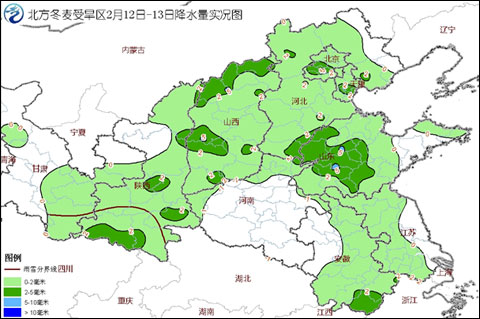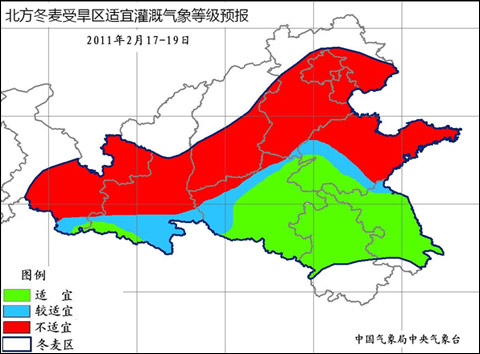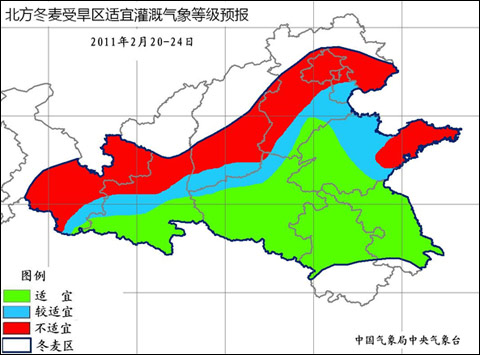Since the winter of last year, precipitation in northern China, especially in North China, has been significantly less than normal, and the drought problem has always been the focus of media attention. After the Spring Festival, the two precipitations arrived on schedule, and Beijing and other places also ushered in the first snow after the winter (9th). So how much precipitation can play a role in drought? What is the current situation of local agriculture? In the future, will the weather situation be beneficial to alleviate the drought? Mao Liuxi, director of the Agricultural Meteorological Center of the China Meteorological Administration, pointed out that the drought situation in the northern region is slightly moderated, but the weather situation in the arid regions of the north is still not optimistic in the future.
"Timely snow" is on schedule
From February 9th to 10th, large-scale rain and snow weather occurred in most of the central and eastern parts of China including the arid regions such as Beijing, Shanxi, Henan and Hebei. Only one day, from February 12th to 13th, snowfall occurred in most parts of the northern winter wheat arid area, including central and southern Shaanxi, northwestern and central mountains, southern Hebei, Beijing, Tianjin, northeastern and southwestern parts of the mountains. Snowfall of 2 to 4 mm occurred in some areas, and snowfall in central Shandong and Beijing was 5 to 6 mm.

The actual situation of precipitation in the winter wheat arid area in northern China from February 12 to 13
"This precipitation is called "life-saving water" by us. It is well known that since winter in North China and other places, there has been almost no obvious precipitation. Although winter is not the period of greatest demand for agricultural water, the drought has indeed begun to spread in the north. The precipitation is really too timely."
As Mao Liuxi said, according to the agricultural situation of the Ministry of Agriculture, as of 17:00 on February 12 (before the precipitation process), the drought-affected area of ​​winter wheat in Hebei, Henan, Shandong, Shanxi, Jiangsu, Anhui, Shaanxi and Gansu provinces reached 10,824. Ten thousand mu, accounting for 39.5% of the planting area, of which 23.9 million mu was seriously affected by drought, accounting for 8.7% of the planted area.
Snowfall improves winter wheat drought area
The results of soil moisture monitoring on February 14 showed that in the unsealed areas of soil, the relative humidity of shallow soils in southern Gannan, south of Guanzhong, southern Hebei, western Henan, north central Shandong, northern Anhui, etc. was below 60%, Henan Local areas such as the western region and northern Anhui Province are below 40%, and the grievances are poor. Except for parts of northern Anhui, the deep soils in all parts of the country are better.
“This snowfall has played a certain role in relieving the drought. Generally, we have defined that the precipitation will reach 10 mm, which can play a certain role in alleviating the drought. The snowfall process is mostly 3~5 mm, although There is still a certain distance from this standard, but the improvement of the surface is still obvious." Indeed, with the melting of snow, the surface defects of 10 cm soil will be improved, and serious shortages in Shandong, Henan and Anhui are expected. The soil surface in the reclamation area will reach more than 60%.
Mao Liuxi also pointed out that the so-called "life-saving water" is only a temporary life-saving. It is not really a relief of the drought. At present, the soil has not yet been revitalized. The precipitation has limited improvement of soil moisture below 20 cm, with snow melt water. The slow infiltration, it is expected that the effective water that can be used by the crop will increase.
In the next 10 days, winter wheat is still less affected by drought in the dry area.
It is expected that in the next ten days, there will be weak precipitation in the meteorological arid regions such as the eastern part of the northwestern region, the southwestern and northern parts of North China, and the western and southern parts of Henan. The precipitation is generally less than 2 mm. The main precipitation period is from 17th to 18th. The specific forecast is as follows:
Shaanxi: Around the 18th, there is 1 to 5 mm of snowfall (rain) in the central and southern Shaanxi.
Gansu: From 17th to 18th, there is 1~5mm snowfall (rain) in the central and eastern part of Gansu.
Shanxi: On the 18th, there was a snowfall of about 1 mm in the southwest of Shanxi.
Henan: On the 18th, there were 1-2 mm of snowfall (rain) in western and southern Henan.

Forecast of Suitable Irrigation Meteorological Grades in Winter Arid Regions in North China from February 17 to 19, 2011
“Winter wheat has no obvious precipitation in most of the arid areas, and the drought cannot be effectively alleviated. The drought in some areas will continue. All localities should be scientifically irrigated according to weather conditions. It is recommended that winter wheat and drought-affected areas suitable or suitable for irrigation should be warm and sunny. In the afternoon, sprinkler irrigation or small water irrigation, avoid flooding with large water, so as to avoid freezing the wheat on the surface; taking irrigation, straw cover and other measures to ensure warming; While watering, apply proper amount of organic fertilizer to promote root sputum." Mao Liuxi said.

Forecast of suitable irrigated meteorological grades for winter wheat in the arid regions of northern China from February 20 to 24, 2011
At present, winter wheat is still in the wintering period in most of the northwestern region, most of North China, the upper part of Huanghuai, and the northern part of Jianghuai. The drought has little effect on the growth of winter wheat. However, as the wheat returns from green to south in the middle and late February, the water demand increases. The effect of drought on winter wheat will gradually increase, which is unfavorable to the population structure and ear development of winter wheat. Especially in the middle of March, when the winter wheat is up and jointed, the drought will affect the number of ears and the size of the ear.
Alkyl Polyglycoside,Processing Agent,Rubber Accelerator
Meikewote Trade Co., Ltd. , http://www.rubber-auxiliarys.com